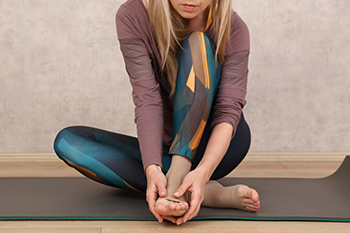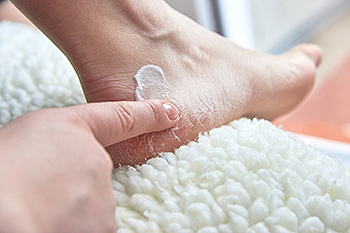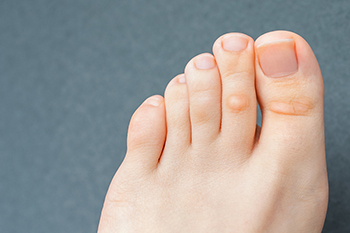Items filtered by date: January 2022
Ways to Repair Cracked Heels
About one-fifth of adults in the United States experience cracked heels, studies show. Besides being unsightly, cracked heels that deepen can also become painful and lead to bleeding. Because there are no oil glands on the feet, they often become dried out. In addition, medical conditions such as diabetes, psoriasis and eczema can promote cracked heels. One of the simplest remedies for cracked heels is a petroleum jelly treatment. It helps reduce moisture loss from the skin and keeps it hydrated. Soak your feet in warm water for about 15 minutes, and then use a pumice stone to scrub off the dried skin. Rinse and pat dry thoroughly. Next, apply moisture lotion to the affected area and cover that with petroleum jelly to seal it in. Put on a pair of wool socks overnight and wash your feet again the next morning. If cracked heels continue to give you problems, it is suggested that you visit a podiatrist who can recommend further treatment options.
Cracked heels are unsightly and can cause further damage to your shoes and feet. If you have any concerns, contact one of our podiatrists from Ultimate Foot Care . Our doctors can provide the care you need to keep you pain-free and on your feet.
Cracked Heels
Cracked heels appear unappealing and can make it harder for you walk around in sandals. Aside from looking unpleasant, cracked heels can also tear stockings, socks, and wear out your shoes. There are several methods to help restore a cracked heel and prevent further damage.
How Do You Get Them?
Dry skin is the number one culprit in creating cracked heels. Many athletes, walkers, joggers, and even swimmers suffer from cracked heels. Age and skin oil production play a role to getting cracked heels as well.
Promote Healing
Over the counter medicines can help, especially for those that need instant relief or who suffer from chronic dry feet.
Wear Socks – Wearing socks with medicated creams helps lock in moisture.
Moisturizers – Applying both day and night will help alleviate dryness which causes cracking.
Pumice Stones – These exfoliate and remove dead skin, which allows for smoother moisturizer application and better absorption into the skin.
Change in Diet
Eating healthy with a well-balanced diet will give the skin a fresh and radiant look. Your body responds to the kinds of food you ingest. Omega-3 fatty acids and zinc supplements can also revitalize skin tissue.
Most importantly, seek professional help if unsure how to proceed in treating cracked heels. A podiatrist will help you with any questions or information needed.
If you have any questions, please feel free to contact our office located in Smithtown, NY . We offer the newest diagnostic and treatment technologies for all your foot care needs.
Why Do Corns Form on the Feet?
Corns are patches of thickened, hardened, raised skin that can develop on the soles of the feet or on the toes in response to excessive pressure or friction. Your skin contains a protein called keratin. This protein holds the skin cells together and helps your skin protect itself from the elements. When your skin is exposed to friction or pressure over and over again, it responds by producing a thick, tough layer of keratin over the injured area, leading to a corn or callus. Although corns arise as a protective measure, they can sometimes cause more harm than good. You may find that a corn is causing you pain or discomfort when you walk, or that it rubs against your shoes uncomfortably. In some cases, a corn can also become infected. If you have painful corns, it is suggested that you see a podiatrist for treatment.
If you have any concerns regarding your feet and ankles, contact one of our podiatrists of Ultimate Foot Care . Our doctors will treat your foot and ankle needs.
Corns: What Are They? and How Do You Get Rid of Them?
Corns can be described as areas of the skin that have thickened to the point of becoming painful or irritating. They are often layers and layers of the skin that have become dry and rough, and are normally smaller than calluses.
Ways to Prevent Corns
There are many ways to get rid of painful corns such as wearing:
- Well-fitting socks
- Comfortable shoes that are not tight around your foot
- Shoes that offer support
Treating Corns
Treatment of corns involves removing the dead skin that has built up in the specific area of the foot. Consult with Our doctors to determine the best treatment option for your case of corns.
If you have any questions please feel free to contact our office located in Smithtown, NY . We offer the newest diagnostic and treatment technologies for all your foot and ankle needs.
Tired of Getting Cold Feet?
 Cold feet, generally caused by poor blood flow, often increases as we age. Causes can be linked to having a more sedentary lifestyle, obesity, diabetes and smoking. But the sensation of cold feet, while annoying, can also indicate much more serious conditions, such as Deep Vein Thrombosis, or blood clots; hardening of the arteries, or atherosclerosis. These conditions can be life threatening and should not be overlooked. Some ways you can improve circulation to the feet include lowering blood pressure with a healthy diet, getting more exercise, and keeping your feet elevated by using a recliner. If symptoms of cold feet persist, please consult a podiatrist to find out more information on treatment methods.
Cold feet, generally caused by poor blood flow, often increases as we age. Causes can be linked to having a more sedentary lifestyle, obesity, diabetes and smoking. But the sensation of cold feet, while annoying, can also indicate much more serious conditions, such as Deep Vein Thrombosis, or blood clots; hardening of the arteries, or atherosclerosis. These conditions can be life threatening and should not be overlooked. Some ways you can improve circulation to the feet include lowering blood pressure with a healthy diet, getting more exercise, and keeping your feet elevated by using a recliner. If symptoms of cold feet persist, please consult a podiatrist to find out more information on treatment methods.
Poor circulation is a serious condition and needs immediate medical attention. If you have any concerns with poor circulation in your feet contact one of our podiatrists of Ultimate Foot Care . Our doctors will treat your foot and ankle needs.
Poor Circulation in the Feet
Poor blood circulation in the feet and legs is can be caused by peripheral artery disease (PAD), which is the result of a buildup of plaque in the arteries.
Plaque buildup or atherosclerosis results from excess calcium and cholesterol in the bloodstream. This can restrict the amount of blood which can flow through the arteries. Poor blood circulation in the feet and legs are sometimes caused by inflammation in the blood vessels, known as vasculitis.
Causes
Lack of oxygen and oxygen from poor blood circulation restricts muscle growth and development. It can also cause:
- Muscle pain, stiffness, or weakness
- Numbness or cramping in the legs
- Skin discoloration
- Slower nail & hair growth
- Erectile dysfunction
Those who have diabetes or smoke are at greatest risk for poor circulation, as are those who are over 50. If you have poor circulation in the feet and legs it may be caused by PAD and is important to make changes to your lifestyle in order to reduce risk of getting a heart attack or stroke. Exercise and maintaining a healthy lifestyle will dramatically improve conditions.
As always, see a podiatrist as he or she will assist in finding a regimen that suits you. A podiatrist can also prescribe you any needed medication.
If you have any questions please feel free to contact our office located in Smithtown, NY . We offer the newest diagnostic and treatment technologies for all your foot and ankle needs.










